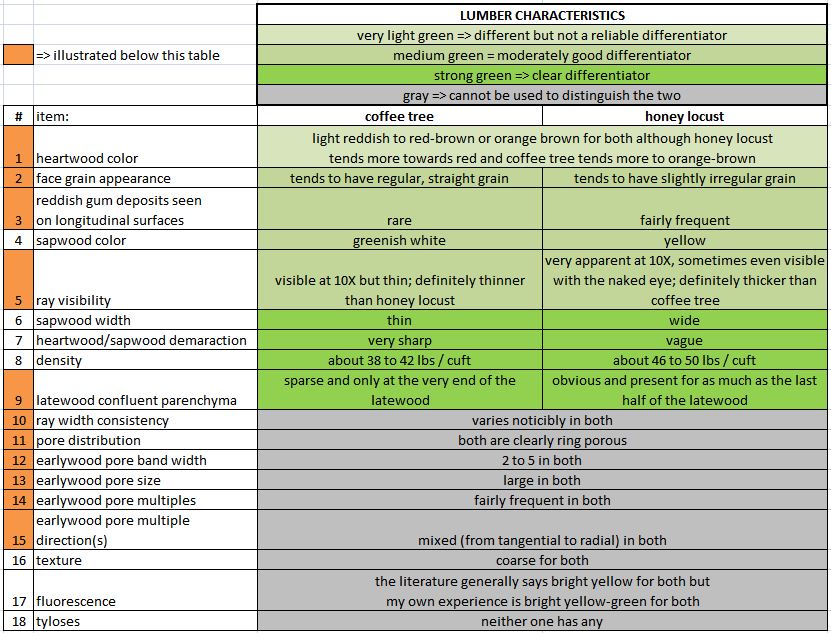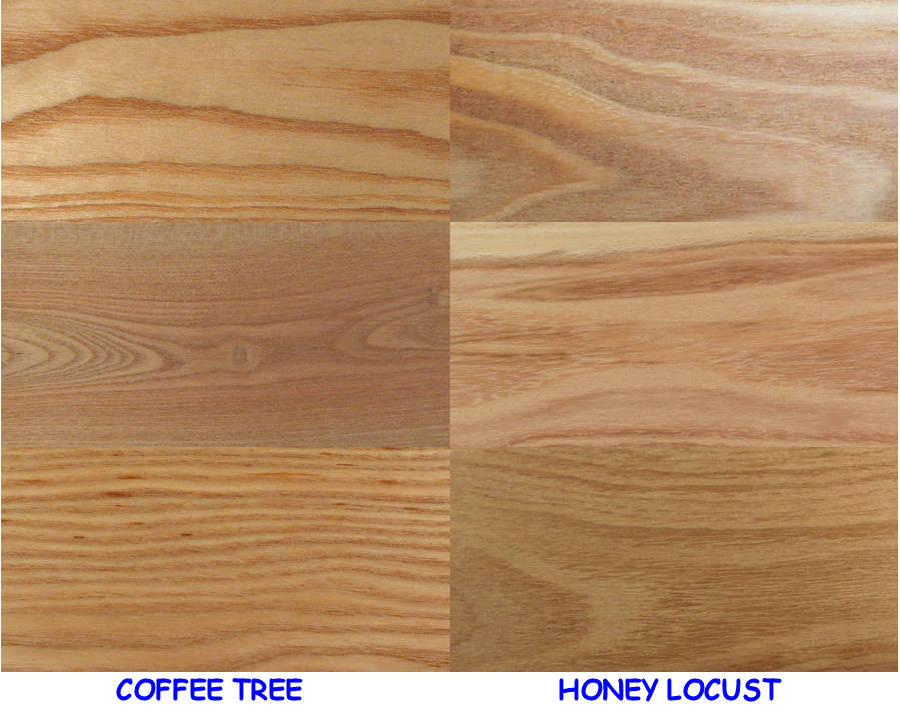LUMBER CHARACTERISTICS COMPARISON
COFFEE TREE v.s. HONEY LOCUST

ITEMS NOT ILLUSTRATED Because I deal in modest sized planks, I have no logs with which to show the sapwood width, color, and demarcation from heartwood. I have a few pieces of honey locust with some sapwood and they confirm the statement that the demarcation is vague for that wood. I can't confirm from personal observation that the demarcation in coffee tree is sharp. My own samples are consistent with the densities stated and I have verified fluorescence in both, as stated in item 17. The lack of tyloses is pretty apparent in the end grain pics below. LATER: I now have a honey locust branch section that clearly shows the vague heartwood/sapwood boundary.

ITEMS 1 AND 2 The left column is three 5" x 2.5" sections of coffee tree face grain and the right column is three 5" x 2.5" sections of honey locust. Even the cathedral grain face in the middle coffee tree piece shows the regularity of grain lines that is typical of coffee tree and the upper two pieces of honey locust show the irregular grain that is typical of that wood. This also shows that the heartwood color tends more towards red in the honey locust and orange-brown in coffee tree but it also shows that this is not a reliable indicator in general as the middle piece of coffee tree is as red as any honey locust and the bottom piece of honey locust is quite brown.

ITEM 3 Reddish gum deposits seen in the face grain of coffee tree and honey locust (both images are of 2" x 1" sections). The literature says that this is much more common in honey locust than in coffee tree but in my own limited experience (about 10 different samples of each wood) that is NOT the case. In my samples it occurs as often in coffee tree as it does in honey locust so I don't consider this to be as strong an indicator as the literature suggests it should be.

 ITEMS 5 and 9 to 15 The top row is a set of three coffee tree end grain shots and the bottom row is a set of three honey locust end grain shots. All are 1/4" x 1/4" shown here at about 12X.
ITEMS 5 and 9 to 15 The top row is a set of three coffee tree end grain shots and the bottom row is a set of three honey locust end grain shots. All are 1/4" x 1/4" shown here at about 12X.
- ITEM 5 Clearly the rays in the honey locust are never as thin as the ones in the 1st and 3rd pieces of coffee tree but the middle piece of coffee tree has rays that are only marginally thinner than those in the honey locust so this is only a moderately good differentiator.
- ITEM 9 Here we have a clear differentiator. Each row is arranged so that the piece to the left has a smaller amount of latewood confluent parenchyma for that type of wood than the one to its right, so that the far right has the most for that type of wood. The confluent parenchyma in the first piece of coffee tree is just about non existent and the larger amount in the 3rd piece is clearly less than the amount in the piece of honey locust on the left (that has the least for that wood). This can take a bit of experience, but once you're used to looking at these things, it's very clear that this is a strong differentiator.
- ITEM 10 Clearly both woods have considerable variation in the width of the rays.
- ITEM 11 Obviously ring porous for both.
- ITEM 12 The width of the earlywood pores is a bit hard to tell because they are not nice neat single rows but rather a fairly random arrangement in the radial direction. Even so, it's pretty clear that no row is less than 2 pores wide and not more than 5 pores wide.
- ITEM 13 Obviously, both woods have fairly large earlywood pores and they are all about the same size, with the coffee tree occasionally showing ones that appear slightly larger than those in the honey locust, but not by much.
- ITEM 14 I didn't circle all of the pore multiples in these pieces but if you look around you'll see quite a few.
- ITEM 15 I've circled in blue, for each wood, a radial pore multiple and in yellow a tangential pore multiple.
references: My wood research always encompasses a number of books and web sites, but two that stand out in particular for this article are:





